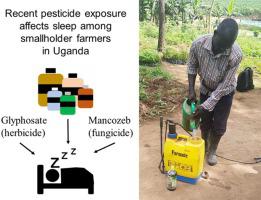Environment International ( IF 10.3 ) Pub Date : 2021-09-27 , DOI: 10.1016/j.envint.2021.106878 Samuel Fuhrimann 1 , Iris van den Brenk 1 , Aggrey Atuhaire 2 , Ruth Mubeezi 3 , Philipp Staudacher 4 , Anke Huss 1 , Hans Kromhout 1

|
Background
Poorly educated smallholder farmers in low-income countries are highly exposed to pesticides. This can result in adverse mental health issues, of which sleep problems might be an underlying indicator. We aim to examine the association between sleep problems and pesticide exposure among smallholder farmers in Uganda.
Methods
A cross-sectional survey with 253 smallholder farmers was conducted between October and December 2019. Sleep problems were assessed during the week before the visit using the Medical Outcomes Study Sleep Scale (MOS-SS). Exposure to pesticides was assessed as application days of any pesticide and as use of 2,4-D, glyphosate, mancozeb, organophosphates & carbamates, pyrethroids and other pesticides during the week and year prior to the visit. Associations were assessed using adjusted multivariable logistic regression models.
Results
Increased odds ratio (OR) for the sleep problem index 6-items (OR [95% Confidence Interval] 1.99 [1.04; 3.84] and 3.21 [1.33; 7.82]), sleep inadequacy (1.94 [1.04; 3.66] and 2.49 [1.05–6.22]) and snoring (3.17 [1.12; 9.41] and 4.07 [1.04; 15.14]) were observed for farmers who respectively applied pesticides up to two days and three or more days in the past week compared to farmers who did not apply during the past week. Gender-stratified analyses showed a higher OR for female applicators (4.27 [1.76–11.16]) than for male applicators (1.82 [0.91–3.79]) for the association between the sleep problem index 6-items and pesticide use in the week before the visit. Increased ORs were also observed for the association between the sleep problem index 6-item and mancozeb exposure during the past year 2.28 [1.12–4.71] and past week 2.51 [0.86–7.55] and glyphosate exposure during the past week 3.75 [1.24–11.8] compared to non-applicators.
Discussion
Our findings suggest an increased risk of sleep problems among smallholder farmers in a pesticide-exposure-dependent way in a low-income context. Further gender-stratified, longitudinal investigations are warranted to confirm these findings.
中文翻译:

最近接触农药会影响睡眠:乌干达小农的横断面研究
背景
低收入国家受教育程度低的小农很容易接触到杀虫剂。这可能会导致不良的心理健康问题,其中睡眠问题可能是一个潜在的指标。我们旨在研究乌干达小农的睡眠问题与农药暴露之间的关系。
方法
在 2019 年 10 月至 2019 年 12 月期间,对 253 名小农进行了一项横断面调查。在访问前一周使用医学结果研究睡眠量表 (MOS-SS) 评估了睡眠问题。在访问前一周和一年内,以任何农药的施用天数和 2,4-D、草甘膦、代森锰锌、有机磷酸盐和氨基甲酸酯、拟除虫菊酯和其他农药的使用天数来评估农药暴露情况。使用调整后的多变量逻辑回归模型评估关联。
结果
睡眠问题指数 6 项的优势比 (OR) 增加(OR [95% 置信区间] 1.99 [1.04; 3.84] 和 3.21 [1.33; 7.82]),睡眠不足(1.94 [1.04; 3.66] 和 2.49 [1.05] –6.22])和打鼾(3.17 [1.12; 9.41] 和 4.07 [1.04; 15.14])与过去一周内分别施用农药达 2 天和 3 天或更长时间的农民相比,与未施用农药的农民相比过去一周。性别分层分析显示,女性施药者(4.27 [1.76-11.16])比男性施药者(1.82 [0.91-3.79])的睡眠问题指数 6 项与农药使用前一周之间的关联具有更高的 OR访问。在过去一年 2.28 [1.12-4.71] 和过去一周 2.51 [0.86-7] 期间,睡眠问题指数 6 项与代森锰锌暴露之间的关联也观察到 ORs 增加。
讨论
我们的研究结果表明,在低收入环境中,小农户因接触农药而出现睡眠问题的风险增加。需要进一步按性别分层的纵向调查来证实这些发现。











































 京公网安备 11010802027423号
京公网安备 11010802027423号